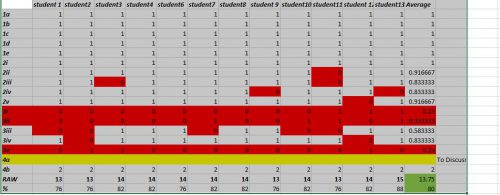There are several methods of providing generic feedback:
For assignments, lab reports:
Incorporate holistic comments online or in-class
In summative situations where double marking procedures slow down the return of feedback, which might then be too late to be useful, you could put some generic feedback online more quickly for the whole class before grades are released.
For formative or two-stage assignments with drafts, you could pre-prepare a comment sheet or slide to discuss in class. Online options work here too, although it may also increase workload in providing office hours to discuss individual issues, whereas in class you can answer questions immediately.
For MCQ exams:
Use analytics
When giving exam feedback, collating a spreadsheet of marks and answers to show students can reduce the amount of time going through the exam question by question. Questions that the majority of the class have answered correctly can be ignored to focus on the more problematic questions. This can also serve the purpose of trialing exam questions.
Here is a simplistic example where only questions highlighted in red were discussed because they were problematic to most students in the cohort:

Exam analytics can be more easily done online through KEATS.
This does not work as well on more subjective short essay type questions however.
Go over exams and problem sheets in class (peer instruction)
An alternative to the teacher giving and explaining answers on practice or mid-term exams is for groups to peer-teach each other. The procedure can be similar to the two–stage exam where students go through answers and solve the questions in groups in class.
Answers can then be given on a sheet or slides by the teacher where students mark their own (or a partner’s) work. Any questions that whole groups did not understand can be addressed in plenary.
In order to counter cheating (if the exam is summative), it is still necessary for the teacher to go through the papers afterwards. It is better if this is done before.
Use a comments bank or pro-formas (click this link to see more information about how to do this through this resource)
How do I address potential challenges?
Do I need to make any modifications for accessibility/inclusivity? Can I build these into the design?
It reduces the emotional effect of negative feedback. You can pick out examples of mistakes (or good work) to show the class without referring to individual students.
Consider the usual modifications for visually impaired students by making online feedback sheets accessible.
If students have extensions for assignments, you can delay feedback.
Do I need to make any modifications for large cohort sizes? Will it be time consuming to set up or mark? Is there anything I can do to modify it to address this?
The point of generic feedback is to reduce time and workload. However, assignments still need to be looked at and comments prepared to be useful to students. Look at the Giving effective written feedback resource for tips.
If students do not complete formative work, you can choose whether to deny them access to generic feedback in order to reduce complaints from those students who have done the work. For example, you can email the generic comment sheet to individuals rather than providing it online (although this increases admin time). Alternatively, you can inform students that everyone will receive feedback but it will benefit the ones how have done the work on time more.
How do I introduce it to students?
This might not be initially a popular method of giving feedback. According to NUS data, students prefer individual feedback to generic feedback. However, if generic feedback is not the only method of giving feedback, and is supplemented at various points in the module with individual and peer feedback, students are more likely to accept the trade-off of receiving personalised feedback for receiving it in a timely manner.
McArthur (2018) found that creating culture of trust between teachers and students is more important than the method of feedback. If generic feedback can show that teachers care and are interested in their students’ learning, it is preferable to ploughing through endless scripts only to provide less effective feedback.
